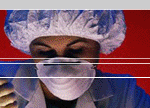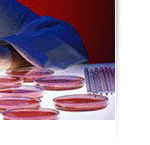Click here to go back.
ADVANCES MADE WITHOUT ANIMALS
In addition to the information on these pages, check out all the alternatives available through The Science Bank, visit: https://thesciencebank.org/
Scientific and medical progress has been achieved through human-based research and even serendipity, but rarely from animal models. Animal experimentation is frequently credited with such advances, but a closer look reveals the truth: the information was already obtained through non-animal methods, or the animals used were not necessary to the outcome of the study.
Vivisectors perpetuate this system of trying to authenticate human-
based discoveries and even hunches by applying them to animals. The industry, and the general public, accepts their animal-based results as valid, even if human data show differently. Why such a convoluted process? Simple: if people were aware that all advances are dependent on research methods other than animal models, those who experiment on animals, and all who financially gain from vivisection would be out of work.
There are many non-animal tests and procedures available to laboratories, which are effective, legitimate, and safe. Most are even cheaper than corresponding animal-based experiments.
In vitro research continues to pass vigorous scientific validation procedures; no traditional animal-based safety test was validated nor would it be able to provide the level of proof required of new in vitro methods. In vitro research is conducted in a controlled environment, such as a test tube or petri dish, assuring clear observations and precise conclusions. Since most diseases attack on the microscopic level, this approach is ideal for learning about human diseases. In vitro models and simulations of the human lung, gastrointestinal system, brain and blood-brain barrier have been developed, providing invaluable and accurate information about diseases such as Alzheimer’s and epilepsy.
When using human blood and tissue to determine toxicity, in vitro experiments provide results that are two to three times more accurate than tests conducted on animals. In vitro methods are becoming increasingly specific, making it easier than ever to determine a substance’s effect on a human eye, human skin, or other organs. This field has created three-dimensional equivalents of the human eye and skin, perfect for determining toxicity, studying burns, and assessing irritation.
In vitro research has given us enormous amounts of relevant data in almost every field of medicine, so we will list only a few of in vitro’s contributions. The Ames test predicts carcinogenic effects of over 300 chemicals, in only a few days. Human Keratinocyte and Neutral Red Bioassay work with cells that correspond to human eyes and skin, providing information on human reactions, irritation and safety regarding numerous compounds. Human tissue has taught researchers much about human diseases and effects of substances. Penicillin and streptomycin were discovered in vitro, two of thousands of discoveries made by focusing on the human body.
Epidemiology is the study of human disease trends within whole populations. Linking various factors, like lifestyle and heredity, to diseases reveals important connections. For example, epidemiological studies linked smoking to lung disease, a relationship not observed in animal experiments. By studying the progression of a disease, who it afflicts and how, researchers are more prepared to determine the causes, and hence, preventive measures. Epidemiology has the potential to save millions more lives, yet is often overlooked in favor of the more immediate albeit inaccurate results obtained from animal experimentation.
Epidemiology establishes connections between habits and diseases. It has identified all known environmental poisons and occupational diseases. It has established a link between heart disease and diet, exercise, cigarettes and hypertension. Epidemiology has linked cancer with smoking, diet, glass fibers, and asbestos. It has demonstrated causes of fetal alcohol syndrome, cholera, birth defects, malaria and more. Through epidemiology we now know the dangerous effects of lead and mercury. This information was not readily accepted because animal data showed otherwise, delaying people’s knowledge and subsequent life-changes
Epidemiology sometimes utilizes human genetic research, an approach that reveals essential data. By discovering which genes cause humans to be predisposed to certain conditions, scientists are currently working toward correcting these atypical traits.
Just as important is clinical research. Observing and analyzing a patient’s condition and responses to treatments provide doctors with vital information. How better to verify the efficacy or safety of a procedure or medication than by monitoring those who receive it? Recording human conditions and reactions is a precise way to learn about side effects, success rates, and secondary uses of a medication or therapy.
Clinical studies on patients have given us treatments for childhood leukemia, thyroid disease, current HIV and AIDS therapies and more. Through clinical observation the heart-lung bypass machine was perfected; hepatitis A was distinguished from hepatitis B; and medications are found to be beneficial, ineffective and/or potentially dangerous. Clinical research determined how AIDS is transmitted, and therefore taught people how they could prevent infection. Clinical research is absolutely invaluable for our health and safety.
Autopsies have revealed or clarified essentially every human disease. They offer precious information and opportunities in learning about the human anatomy, physiology, disease manifestation and more. Unfortunately, autopsies are expensive and therefore not conducted frequently enough. If funds from animal experiments were redirected into autopsies, the medical and scientific community would collect vast amounts of pertinent information, potentially saving many more lives.
Autopsies have already contributed greatly to medicine. They are responsible for the discovery or clarification of essentially every disease. They provide accurate, precise direction for students learning anatomy, biology, physiology, surgical techniques, and more. Although autopsies are more costly than other replacements, the amount of valid data they provide is worth it, especially considering how many billions are being wasted on inconclusive, duplicative animal experiments.
Technological advancements, including computer and mathematical modeling, have given us priceless tools. CAT and MRI scans, x-rays, ultrasounds, and systems that predict drug effects on cancer cells are only a small example of how this field has benefited from scientific advancements. Technology has improved our understanding of disease processes and offers accurate diagnosis and effective treatments.
Technological advances have given us x-rays, microscopes, and many kinds of scanners (CAT, MRI, ultrasound, etc). Technology has provided us with blood analysis equipment, pulmonary artery catheters, and brain and heart monitors (EEGs and EKGs), allowing us to “see” inside the body. It has given us cameras so tiny that one can fit into a pill and be swallowed by a patient, showing the doctors the inside of that person’s gastrointestinal system. Computer programs demonstrate surgical techniques and treatments for various diseases. We now have a heart device that helps pump blood, extending the lives of patients with heart failure.
Post-marketing drug surveillance could potentially save millions of lives. By instituting a system in which all medication-users report any and all effects of their medication, adverse reactions would be made immediately clear, saving humans from injuries and death. This kind of system would also reveal new uses for existing medications. Unfortunately physicians are not mandated to report patients’ side effects, and therefore usually don’t. If such monitoring was mandated, ample information would be readily available about each prescription drug, sparing people from dangerous reactions and death.
Specialization in medical care and in hospital units allows professionals to focus on particular diseases, thus ensuring better patient care. This extension in medicine is often overlooked, but has been vital to patients’ survival. The medical and scientific communities spend a lot of time trying to duplicate results from previous studies. This is cruel and wasteful. Human-based research has been conducted for centuries; by investigating existing data, scientists are certain to learn much about their field of research.
Advancements in computer technology and non-animal research have brought us to the dawn of a new era in scientific experimentation.
With the acknowledgement that animals are poor substitutes for humans, and with national and international support and funding, pioneering animal replacements are being turned into reality.
Recent Advancements:
Lung-On-A-Chip Designed to Replace Animal Tests











